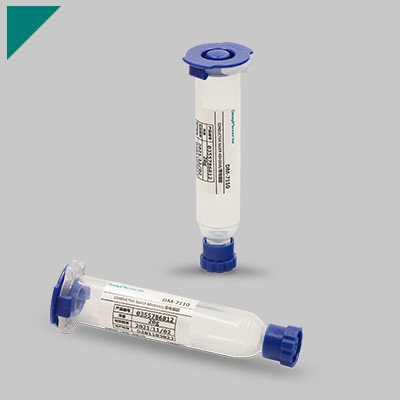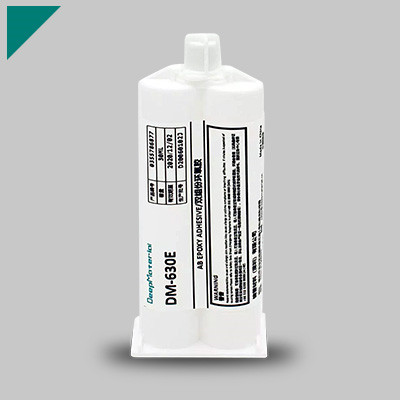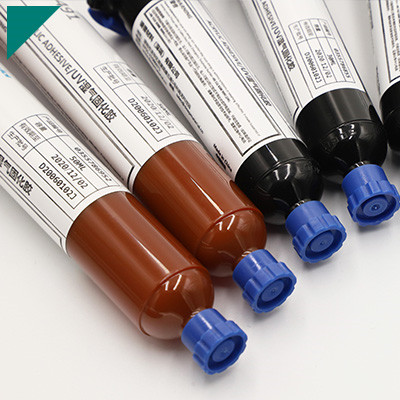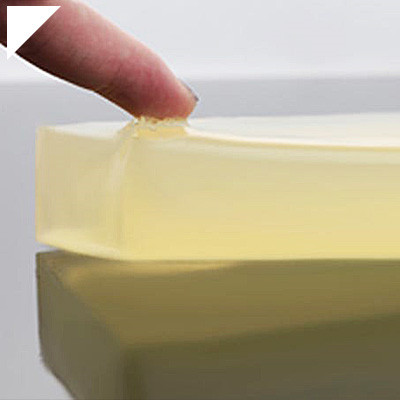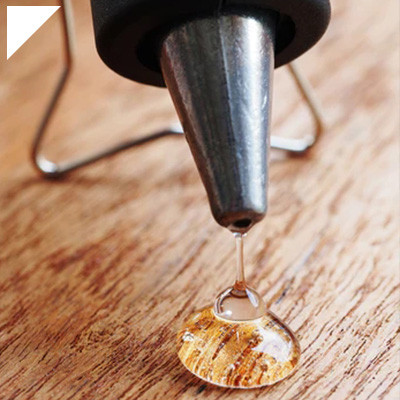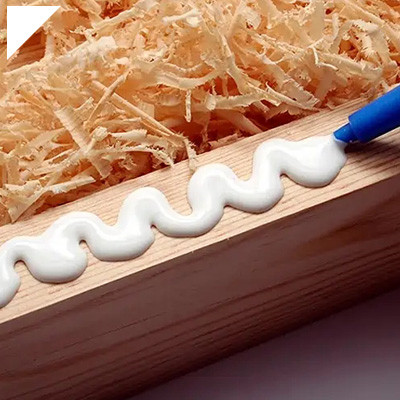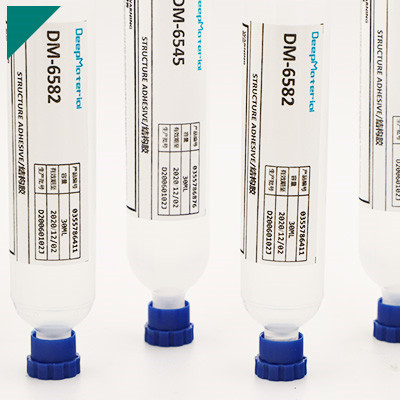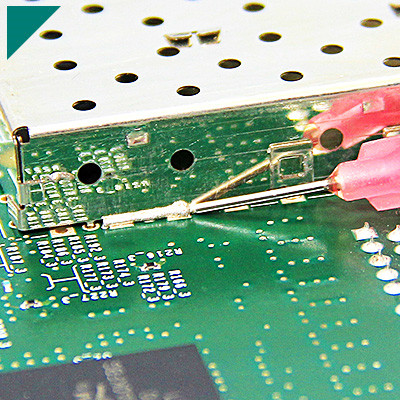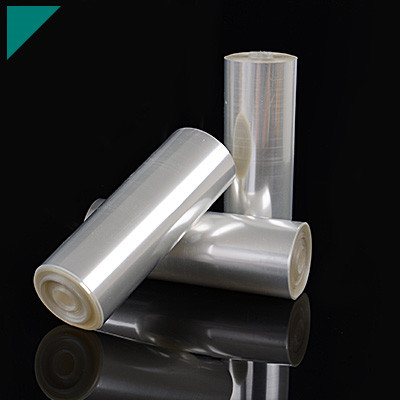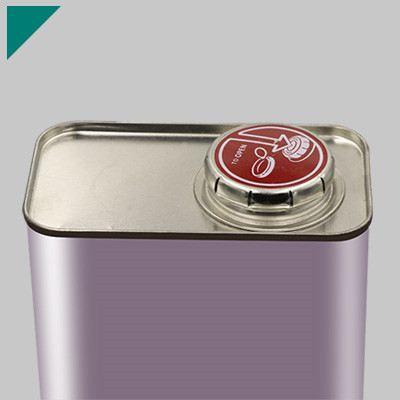Home > Potting Compound > Silicone Potting Compound
Silicone Potting Compound
Silicone potting compounds play a crucial role in various industries, offering excellent protection for electronic components against moisture, vibration, and other environmental factors. Whether you’re an engineer, a hobbyist, or someone curious about these materials, this comprehensive guide will provide insights into silicone potting compounds, their applications, benefits, and much more.
Table of Contents
ToggleWhat are silicone potting compounds, and how do they differ from other potting materials?
Silicone potting compounds are specialized materials that encapsulate and protect electronic components from environmental factors such as moisture, dust, vibration, and thermal shock. These compounds consist of silicone polymers, fillers, curing agents, and additives, carefully formulated to provide optimal protection while maintaining electrical insulation and mechanical integrity. Here’s a closer look at silicone potting compounds and how they differ from other potting materials:
Composition:
- Silicone potting compounds primarily consist of silicone polymers, which offer excellent flexibility and thermal stability.
- They may include various fillers, such as silica, which enhance mechanical properties like strength and hardness.
- Curing agents, typically platinum-based catalysts, facilitate the cross-linking of silicone molecules to form a solid, durable encapsulant.
- Additives such as UV stabilizers, flame retardants, and adhesion promoters can be incorporated to tailor the properties of the compound to specific application requirements.
Key Characteristics:
- Flexibility:Silicone potting compounds exhibit high flexibility, accommodating thermal expansion and contraction without cracking or delamination.
- Chemical Resistance:Silicone materials are inherently resistant to moisture, chemicals, and solvents, providing reliable protection against corrosive elements.
- Electrical Insulation:Silicone potting compounds offer excellent electrical insulation properties, which are crucial for safeguarding sensitive electronic components from short circuits and electrical damage.
- Adhesion:They adhere well to various substrates, including metals, plastics, and ceramics, ensuring robust encapsulation and sealing.
- Differences from Other Potting Materials:
- Epoxy Resins:While epoxy resins also provide effective encapsulation, they tend to be more rigid than silicone compounds, making them prone to cracking under stress.
- Polyurethane Resins:Polyurethane potting compounds offer good mechanical strength and moisture resistance but may degrade when exposed to UV radiation, unlike silicone, which is more UV stable.
- Encapsulation Gels:Silicone potting compounds offer superior thermal conductivity compared to encapsulation gels, making them suitable for applications where heat dissipation is critical.
Silicone potting compounds stand out for their exceptional flexibility, thermal stability, chemical resistance, and electrical insulation properties. While other potting materials have advantages, silicone compounds provide reliable protection for electronic components in diverse and demanding environments.
What are the primary applications of silicone potting compounds?
Due to their versatile properties and robust performance, silicone potting compounds have extensive use across various industries. Here’s a closer look at the primary applications of silicone potting compounds:
- Electronics Encapsulation:Silicone potting compounds are widely employed to encapsulate electronic components such as printed circuit boards (PCBs), sensors, and connectors. By furnishing a safeguarding shield against moisture, dust, and mechanical stress, these compounds ensure the reliability and longevity of sensitive electronic devices in applications ranging from consumer electronics to industrial machinery.
- Automotive Electronics:In the automotive industry, silicone potting compounds play a crucial role in protecting electronic control units (ECUs), sensors, and lighting systems from harsh operating conditions. They withstand temperature fluctuations, vibration, and exposure to automotive fluids, ensuring consistent performance and durability in vehicles.
- LED Lighting:Silicone potting compounds are favored for encapsulating LED modules and drivers due to their excellent thermal conductivity and UV stability. They effectively dissipate heat, extending the lifespan of LED fixtures and maintaining optimal light output in indoor and outdoor lighting applications, including streetlights, architectural lighting, and signage.
- Renewable Energy Systems:Solar inverters, wind turbine controllers, and battery management systems rely on silicone potting compounds to safeguard critical electronic components from environmental and electrical hazards. These compounds offer thermal stability and weather resistance, making them ideal for renewable energy applications exposed to outdoor conditions.
- Medical Devices:Silicone potting compounds are used in medical device manufacturing to protect electronics in devices such as pacemakers, defibrillators, and diagnostic equipment. They meet stringent biocompatibility and sterilization requirements, ensuring the safety and reliability of medical electronics in clinical settings.
- Aerospace and Defense:Silicone potting compounds are specified for aerospace and defense applications where reliability and performance are paramount. They protect avionics, communication equipment, and missile guidance systems from extreme temperatures, altitude changes, and mechanical shock, ensuring mission-critical functionality in challenging environments.
- Marine and Offshore Equipment:In marine and offshore industries, silicone potting compounds provide corrosion resistance and waterproofing for electronics used in navigation systems, underwater sensors, and offshore drilling equipment. They withstand saltwater exposure and harsh marine environments, prolonging the service life of electronic components onboard ships and offshore platforms.
- Consumer Goods:From household appliances to outdoor electronics, silicone potting compounds enhance the durability and reliability of consumer products by protecting electronic assemblies from moisture, impact, and temperature fluctuations. They contribute to the performance and longevity of smart home devices, power tools, and outdoor recreational equipment.
How do silicone potting compounds protect electronic components?
Silicone potting compounds serve as indispensable guardians for electronic components, offering robust protection against many environmental hazards. These compounds ensure the reliability and longevity of electronic devices across diverse industries through a combination of encapsulation, mechanical fortification, thermal regulation, electrical insulation, and chemical resilience. Let’s explore how silicone potting compounds effectively shield electronic components from potential harm.
Encapsulation and Sealing:
The encapsulation process involves enveloping electronic assemblies entirely within a silicone matrix, creating a protective cocoon that shields them from external threats. This encapsulation safeguards against moisture ingress, dust accumulation, and chemical exposure and enhances the structural integrity of the components. Furthermore, silicone potting compounds’ sealing properties prevent contaminants from penetrating, ensuring the electronic assembly’s long-term performance.
Mechanical Protection:
Silicone potting compounds provide vital mechanical reinforcement to electronic components, cushioning them against the rigors of everyday use. By absorbing shock and vibration, these compounds mitigate the risk of mechanical failure and prolong the operational lifespan of the devices. Silicone potting compounds offer invaluable mechanical protection in industrial machinery subjected to constant motion or automotive electronics enduring rough terrain.
Thermal Management:
Effective thermal management is paramount for electronic devices to operate optimally and sustainably. Due to their high thermal conductivity, silicone potting compounds dissipate heat generated by electronic components. By efficiently transferring heat away from sensitive areas, these compounds prevent overheating and thermal stress, ensuring reliable performance even in demanding thermal environments.
Electrical Insulation:
Silicone potting compounds act as barriers against electrical currents, providing essential insulation for enclosed electronic circuits. This insulation prevents electrical interference, short circuits, and other electrical anomalies that could compromise the functionality of electronic devices. Manufacturers can confidently protect their electronics from electrical hazards with silicone potting compounds and maintain consistent performance.
Chemical Resistance:
The chemical resistance of silicone potting compounds is a boon for electronic components operating in harsh chemical environments. These compounds repel a wide array of chemicals and solvents, safeguarding the integrity of the encapsulated electronics. Whether in industrial settings exposed to corrosive substances or marine applications encountering saltwater, silicone potting compounds offer unparalleled chemical resilience.
Essentially, silicone potting compounds serve as multifaceted shields, fortifying electronic components against moisture, mechanical stress, thermal fluctuations, electrical hazards, and chemical exposure. Their versatility and reliability make them indispensable assets in ensuring the robustness and longevity of electronic devices across various sectors.
What are the key properties of silicone potting compounds that make them suitable for various applications?
Silicone potting compounds possess unique properties that render them highly suitable for various applications across diverse industries. These key properties contribute to their effectiveness in protecting electronic components and ensuring the reliability and longevity of electronic devices. Here are some of the key properties of silicone potting compounds:
- Flexibility:Silicone potting compounds exhibit remarkable flexibility, allowing them to conform to the contours of electronic assemblies and substrates. This flexibility enables them to withstand mechanical stress, including thermal expansion and contraction, without cracking or delamination. As a result, silicone potting compounds are ideal for applications where movement or vibration is prevalent, such as automotive electronics and handheld devices.
- Thermal Stability:With exceptional thermal stability, silicone potting compounds can operate effectively over a wide temperature range, from extreme cold to high heat. They maintain their properties and performance even in harsh thermal environments, making them suitable for applications exposed to temperature fluctuations, such as outdoor electronics, LED lighting, and aerospace components.
- Chemical Resistance:Silicone potting compounds offer excellent resistance to moisture, chemicals, and solvents, ensuring the long-term protection of electronic components in corrosive environments. Their ability to withstand water infiltration and chemical corrosion renders them well-suited for use in environments subjected to harsh chemical exposure, including industrial machinery, marine electronics, and automotive sensor systems.
- Electrical Insulation:Silicone potting compounds provide reliable electrical insulation, preventing electrical leakage, short circuits, and other electrical failures. This characteristic is essential for guaranteeing the security and functionality of electronic devices, particularly in high-voltage applications such as power supplies, inverters, and electrical control systems.
- Adhesion:Silicone potting compounds adhere well to various substrates, including metals, plastics, and ceramics, ensuring robust encapsulation and sealing of electronic assemblies. Their strong adhesion properties contribute to encapsulated electronics’ overall durability and reliability, preventing moisture ingress and mechanical damage.
- UV Stability:Some silicone potting compounds are formulated with UV stabilizers, providing enhanced resistance to ultraviolet radiation and outdoor exposure. This UV stability makes them suitable for outdoor applications, such as solar inverters, LED lighting, and outdoor sensors, where prolonged exposure to sunlight is unavoidable.
The exceptional flexibility, thermal stability, chemical resistance, electrical insulation, adhesion, and UV stability of silicone potting compounds make them versatile and reliable solutions for protecting electronic components in various applications across various industries. Their ability to withstand environmental challenges while maintaining performance makes them indispensable assets for engineers and manufacturers seeking to ensure the durability and reliability of electronic devices.
Can silicone potting compounds withstand extreme temperatures?
Silicone potting compounds are highly regarded for their capacity to endure diverse temperature ranges, making them exceptionally well-suited for applications facing extreme thermal challenges. Let’s delve into this topic further:
Wide Temperature Range:
- Silicone potting compounds demonstrate outstanding thermal stability, enabling Consistent functionality across a diverse temperature range.
- They can endure frigid temperatures below freezing, as low as -50°C (-58°F), without becoming brittle or losing flexibility.
- At the other end of the spectrum, silicone compounds can withstand high heat, withstanding temperatures exceeding 200°C (392°F) without significant degradation.
Resistance to Thermal Cycling:
- One key advantage of silicone potting compounds is their ability to withstand thermal cycling, in which components experience alternating periods of heating and cooling.
- These compounds maintain their properties and integrity even after multiple thermal stress cycles, ensuring long-term reliability in applications subject to temperature fluctuations.
Performance in Harsh Environments:
- In addition to withstanding extreme temperatures, silicone potting compounds excel in harsh environmental conditions.
- Whether in outdoor applications exposed to direct sunlight or industrial settings with high ambient temperatures, silicone compounds maintain their performance and effectively protect electronic components.
Applications in Automotive and Aerospace:
- Silicone potting compounds are found to be extensively used in automotive and aerospace applications, where components are exposed to both hot and cold extremes.
- In automotive electronics, these compounds protect control modules, sensors, and wiring harnesses from the heat generated by engine compartments and the cold temperatures experienced during winter.
- In aerospace, silicone potting compounds safeguard avionics systems and electronic components from extreme temperatures at high altitudes and during atmospheric re-entry.
Reliability in Electronics:
- Silicone potting compounds play a crucial role in ensuring the reliability of electronic devices operating in demanding thermal environments.
- Whether in power electronics, LED lighting, or industrial machinery, these compounds provide thermal management and protection against temperature-induced stresses, prolonging the lifespan of electronic components.
Are silicone potting compounds resistant to chemicals and solvents?
Silicone potting compounds are renowned for their Outstanding resilience against an extensive array of chemicals and solvents, making them highly suitable for applications where exposure to corrosive substances is a concern. Let’s explore this topic further:
Chemical Resistance:
- Silicone potting compounds resist various chemicals, including acids, bases, oils, and solvents.
- Even in the face of corrosive substances, they uphold their structural integrity and functionality, safeguarding the encapsulated electronic components from degradation or decline.
Protection Against Corrosive Environments:
- In environments where exposure to chemicals is common, silicone potting compounds provide reliable protection for electronic assemblies.
- They act as a barrier, preventing the ingress of corrosive agents and ensuring the long-term reliability of electronic devices.
Applications in Industrial Settings:
- Silicone potting compounds find widespread use in industrial applications where equipment is subjected to harsh chemicals and solvents.
- They protect electronic components in machinery, sensors, and control systems from damage caused by exposure to chemicals used in manufacturing processes.
Resistance to Automotive Fluids:
- Silicone potting compounds are prized for resisting automotive fluids such as gasoline, oil, and brake fluid in the automotive industry.
- They ensure the integrity of electronic control units (ECUs), sensors, and wiring harnesses, even in the presence of these corrosive fluids found in engine compartments and undercarriages.
Marine and Offshore Applications:
- Silicone potting compounds are also well-suited for marine and offshore applications, where exposure to saltwater and seawater is a concern.
- They protect electronic components onboard ships, offshore platforms, and underwater equipment from corrosion caused by saltwater exposure.
Compatibility with Medical Devices:
- Silicone potting compounds are commonly used in medical devices where exposure to bodily fluids and disinfectants is inevitable.
- They meet stringent biocompatibility standards and ensure the reliability and longevity of electronic components in devices such as pacemakers, defibrillators, and diagnostic equipment.
Silicone potting compounds offer excellent resistance to chemicals and solvents, making them indispensable for protecting electronic components in various industry applications. Their ability to withstand corrosive environments ensures electronic devices’ durability, reliability, and performance, even in challenging operating conditions.
How do you select the right silicone potting compound for a specific application?
Selecting the appropriate silicone potting compound is critical for ensuring the durability, performance, and reliability of electronic components in various applications. With a multitude of options available, several factors must be considered to match the compound to the specific requirements of the application.
Understanding Application Requirements
- Before selecting a silicone potting compound, thoroughly assess the application’s requirements, including environmental conditions, operating temperature range, mechanical stresses, and chemical exposure.
- Determine the level of protection needed against factors such as moisture ingress, thermal shock, vibration, and impact resistance.
Key Considerations
- Chemical Compatibility:Evaluate the silicone compound’s compatibility with substrates, components, and any potential contaminants in the application environment.
- Temperature Resistance:Choose a silicone potting compound with a temperature rating suitable for the expected operating conditions, ensuring it can withstand high and low temperatures without degradation.
- Flexibility vs. Rigidity:Consider whether the application demands flexibility or rigidity in the cured silicone. Flexible compounds are ideal for applications subjected to vibration or thermal expansion, while rigid compounds provide better protection against mechanical stresses.
- Curing Time and Process:
- Assess the curing time and method required for the silicone compound, considering factors such as pot life.
- Cure temperature.
- Cure time to align with production processes.
- Electrical Properties:Determine the application’s electrical insulation requirements and select a silicone compound with appropriate dielectric strength and resistance to electrical breakdown.
- Adhesion:Ensure the silicone potting compound adheres well to various substrates, including metals, plastics, and ceramics, to prevent delamination and provide reliable encapsulation.
- Optical Clarity:For applications where the visibility of components is essential, choose a silicone compound with optical clarity to maintain transparency after curing.
Testing and Validation
- Conduct thorough testing and validation of the selected silicone potting compound under simulated conditions to ensure it meets the application requirements.
- Perform reliability testing, including thermal cycling, humidity testing, and mechanical stress tests, to assess the compound’s long-term performance and durability.
Selecting the suitable silicone potting compound involves comprehensively evaluating application requirements, considering chemical compatibility, temperature resistance, flexibility, curing process, electrical properties, adhesion, and optical clarity. By carefully assessing these factors and conducting thorough testing, you can ensure the chosen compound provides optimal protection and performance for the specific application.
What are the curing methods for silicone potting compounds?
Silicone potting compounds protect electronic components from environmental factors such as moisture, dust, and chemical exposure. However, their effectiveness relies heavily on proper curing methods. In this guide, we explore the various curing methods employed for silicone potting compounds, highlighting their importance in ensuring optimal performance and longevity of encapsulated electronic devices.
Curing Methods for Silicone Potting Compounds
Room Temperature Curing:
One of the most common curing methods for silicone potting compounds is room-temperature curing. This method involves allowing the compound to cure naturally at ambient temperatures without the need for additional heat or specialized equipment. Room-temperature curing is convenient and cost-effective, making it suitable for a wide range of applications.
Heat Curing:
Heat curing involves exposing the silicone potting compound to elevated temperatures to accelerate the curing process. This method typically requires an oven or other heating equipment to control precise temperature. Heat curing can significantly reduce curing times compared to room temperature curing, making it ideal for applications that require rapid turnaround times or where high temperatures are already present in the operating environment.
UV Curing:
UV curing is a relatively new method that utilizes ultraviolet (UV) light to initiate and accelerate the process. Silicone potting compounds designed for UV curing incorporate photoinitiators that activate upon exposure to UV light, initiating the polymerization process and solidifying the material. UV curing offers several advantages, including rapid curing times, precise control over curing parameters, and selective curing of specific areas. However, UV curing may require specialized equipment and only be suitable for some applications.
Importance of Proper Curing
Proper curing is essential for achieving silicone potting compounds’ desired properties and performance characteristics. Inadequate curing can lead to poor adhesion, reduced mechanical strength, and compromised resistance to environmental factors. By following the recommended curing methods and parameters specified by the manufacturer, manufacturers can ensure that their encapsulated electronic devices are adequately protected and maintain reliable performance throughout their operational lifespan.
How does the potting process work, and what are the common techniques used?
Potting is vital in electronics manufacturing. It encapsulates and protects sensitive electronic components from environmental factors like moisture, vibration, and thermal stress. This process involves surrounding the components with a protective material, typically a resin or silicone compound, to ensure their integrity and longevity in various operating conditions.
Working Principle
- Encapsulation:The potting material is poured or injected around the electronic components, forming a protective barrier that encapsulates them entirely.
- Adhesion:The potting material adheres to the components and substrate, creating a strong bond that prevents the ingress of moisture, dust, and other contaminants.
- Curing:After application, the potting material undergoes a process to harden and solidify, forming a durable and stable encapsulation around the components.
Common Techniques
- Pouring: In the pouring technique, the potting material is poured directly onto the components, allowing it to flow and fill the available space around them. This method is suitable for large or irregularly shaped components.
- Encapsulation Molding:Encapsulation molding involves placing the electronic components into a mold cavity and injecting the potting material under pressure. This technique ensures precise encapsulation and is often used for mass production.
- Potting Bags:Potting bags are preformed pouches or bags filled with the potting material. Electronic components are placed inside the bag, and then the bag is sealed and cured, providing a contained and controlled environment for potting.
- Vacuum Potting:Vacuum potting removes air bubbles and ensures complete impregnation of the potting material around the components. The components are situated within a vacuum enclosure, and the potting material is injected under a vacuum, facilitating thorough encapsulation.
- Dipping:Dipping involves immersing the electronic assembly into a bath of liquid potting material, allowing it to coat the components entirely. Multiple dips may be required to achieve the desired thickness of the encapsulation layer.
- Encapsulation Dispensing:Encapsulation dispensing utilizes automated dispensing equipment to precisely apply the potting material to specific electronic assembly areas. This technique offers flexibility and control over the potting process, especially for complex or delicate components.
Can silicone potting compounds be used for outdoor applications?
Silicone potting compounds can be used for outdoor applications, provided they are specifically formulated for such environments. These compounds offer a range of advantageous properties that make them suitable for outdoor use. An essential advantage of silicone potting compounds is their remarkable ability to withstand extreme temperatures, UV radiation, and moisture infiltration—frequent obstacles encountered in outdoor settings. This resilience ensures that the electronic components or devices encapsulated with silicone potting compounds remain protected and functional over extended periods.
Furthermore, silicone potting compounds boast exceptional flexibility and elasticity, which are crucial for outdoor applications where components may be subjected to vibrations, thermal cycling, or mechanical stresses. This flexibility allows the compound to accommodate dimensional changes or movements within the encapsulated assembly without compromising its protective integrity. Moreover, silicone potting compounds demonstrate elevated dielectric strength and electrical insulation characteristics, protecting delicate electronic components against environmental elements like humidity and contamination.
Another advantage of silicone potting compounds is their chemical inertness and resistance to corrosion, ensuring long-term reliability even in harsh outdoor conditions where exposure to corrosive agents or pollutants is a concern. This resistance helps prevent degradation or failure of the encapsulated components, thereby extending their service life and reducing maintenance requirements.
However, Choosing silicone potting compounds tailored for outdoor use is crucial, considering aspects such as anticipated temperature variations, UV exposure, and compatibility with surrounding materials in the application environment. Proper curing and application techniques are also critical to achieving optimal performance and durability. Overall, with the correct formulation and application, silicone potting compounds can provide reliable and long-lasting protection for electronic assemblies in outdoor settings.
Are there any environmental considerations when using silicone potting compounds?
Several environmental considerations merit attention when using silicone potting compounds due to their potential impact on human health and the ecosystem.
- Volatile Organic Compounds (VOCs):Some silicone potting compounds may contain VOCs, contributing to air pollution and adversely affecting air quality and human health.
- Hazardous Ingredients:Certain additives or components in silicone potting compounds, such as catalysts or fillers, may pose environmental hazards if not managed adequately during manufacturing, application, or disposal.
- Waste Management:Disposal of unused or cured silicone potting compounds should adhere to proper waste management practices to prevent contamination of soil and water sources. Recycling or proper disposal methods are essential to minimize environmental impact.
- Biodegradability:Consideration should be given to the biodegradability of silicone potting compounds. While silicone materials are generally not biodegradable, efforts should be made to select compounds with minimal environmental persistence.
- Energy Consumption:Manufacturing processes for silicone potting compounds may consume significant energy, contributing to greenhouse gas emissions and environmental degradation. Utilizing energy-efficient production methods can mitigate these impacts.
- Sustainability:Manufacturers should strive to source raw materials responsibly, opting for sustainable and renewable sources whenever possible. Additionally, investing in research and development to create eco-friendly formulations can reduce the environmental footprint of silicone potting compounds.
- Regulatory Compliance:Adherence to environmental regulations and standards is imperative to guarantee silicone potting compounds’ safe manufacture, utilization, and disposal. Adhering to regulatory requirements helps mitigate ecological risks and promotes sustainable practices within the industry. Addressing these environmental considerations is essential for promoting sustainability and reducing the ecological footprint associated with silicone potting compounds. Manufacturers can minimize adverse environmental impacts and contribute to a more sustainable future by adopting environmentally conscious practices throughout the product lifecycle.
What are the advantages of using silicone potting compounds over other materials?
Silicone potting compounds offer many advantages over alternative materials, making them a preferred choice for encapsulating and protecting electronic components in various applications.
Superior Environmental Resistance
Silicone potting compounds exhibit exceptional resistance to various environmental factors, including moisture, humidity, temperature extremes, and chemical exposure. Such durability guarantees encapsulated electronic assemblies’ sustained performance and dependability, even when subjected to demanding operating conditions.
Excellent Electrical Insulation Properties
Possessing high dielectric strength and minimal electrical conductivity, silicone potting compounds effectively insulate against electrical currents. This property is essential for preventing short circuits and electrical failures in electronic devices, especially in high-voltage applications.
Flexibility and Thermal Stability
Silicone potting compounds offer inherent flexibility, allowing them to withstand mechanical stresses, vibrations, and thermal expansion without cracking or compromising the integrity of the encapsulation. This flexibility enhances the durability of electronic assemblies, particularly in dynamic environments.
Wide Operating Temperature Range
Unlike many other potting materials, silicone compounds maintain their properties over a broad temperature range, from extreme cold to elevated heat. This versatility makes them suitable for applications exposed to fluctuating temperatures or demanding thermal conditions.
Optical Clarity and UV Stability
Some silicone potting compounds feature optical clarity and UV stability, preserving visibility and preventing yellowing or degradation of encapsulated components over time. This transparency is advantageous for applications requiring inspection or monitoring of internal components.
Ease of Application and Compatibility
Silicone potting compounds are available in various formulations, including liquids, gels, and pastes. They offer flexibility in application methods such as pouring, molding, or dispensing. Their compatibility with multiple substrates and components simplifies potting and ensures reliable encapsulation.
Silicone potting compounds’ advantages over other materials are evident in their superior environmental resistance, excellent electrical insulation properties, flexibility, thermal stability, wide operating temperature range, optical clarity, UV stability, ease of application, and compatibility with diverse substrates. These qualities make silicone potting compounds preferred for protecting electronic assemblies, ensuring optimal performance, longevity, and reliability in challenging environments.
Are there any disadvantages or limitations to using silicone potting compounds?
While silicone potting compounds offer many advantages, they have limitations and drawbacks. One notable limitation is their relatively high cost compared to other potting materials, such as epoxy resins or polyurethanes. The manufacturing process of silicone compounds involves sophisticated chemistry and specialized equipment, leading to higher production costs, which can impact overall project budgets.
Additionally, silicone potting compounds typically have lower mechanical strength and hardness than other potting materials like epoxy resins. This characteristic can disadvantage an application where physical impact resistance is crucial. In scenarios where components are subjected to significant mechanical stresses or vibration, silicone potting compounds may not provide sufficient protection against damage or deformation.
Another consideration is the curing time of silicone potting compounds. While they offer excellent flexibility and adhesion properties once cured, the curing process can be relatively slow compared to other potting materials. This extended curing time may result in longer production lead times or assembly processes, potentially affecting project timelines.
Furthermore, silicone potting compounds may not be compatible with specific substrates or components. It is essential to verify compatibility with materials such as plastics, metals, or circuit board coatings to prevent such problems as adhesion failure or chemical interactions that could compromise the performance of the encapsulated assembly.
Finally, while silicone potting compounds exhibit excellent resistance to various environmental factors, they may not be suitable for applications requiring extremely high-temperature resistance beyond their specified operating range. In such cases, alternative potting materials with higher temperature resistance may be more appropriate.
Despite these limitations, silicone potting compounds remain A preferred option for numerous applications because of their unique properties, including flexibility, electrical insulation, and resistance to environmental factors. Careful consideration of each application’s specific requirements and constraints is essential to determine whether silicone potting compounds are the most suitable solution.
How do you ensure proper adhesion of silicone potting compounds to substrates?
Ensuring proper adhesion of silicone potting compounds to substrates is crucial for achieving reliable encapsulation and protection of electronic components. Poor adhesion can lead to delamination, voids, or encapsulation failure, compromising the assembly’s integrity. Several techniques and considerations are essential to promote strong adhesion between the silicone compound and substrates.
Surface Preparation
- Cleaning: Thoroughly clean the substrate surface to remove any contaminants such as dust, grease, oils, or residues that could inhibit adhesion. Solvent cleaning or mechanical methods such as abrasion may be necessary to achieve a clean, residue-free surface.
- Degreasing: Remove any traces of oils or grease using appropriate degreasing agents to ensure optimal adhesion between the substrate and silicone potting compound.
- Etching: In some cases, etching the substrate surface with chemical or mechanical methods can enhance surface roughness and promote mechanical interlocking between the substrate and the potting material, improving adhesion.
Priming and Surface Treatment
- Priming: Apply a suitable primer or adhesion promoter to the substrate surface to enhance bonding between the substrate and the silicone potting compound. Primers can improve wetting and adhesion by promoting chemical bonding or providing a compatible interface between the substrate and the potting material.
- Silane Coupling Agents:Silane coupling agents can improve adhesion by forming chemical bonds between the substrate surface and the silicone compound. These agents are particularly effective for enhancing adhesion to glass, metals, or ceramics.
Selection of Compatible Materials
- Match Substrate and Potting Material:Ensure compatibility between the substrate material and the silicone potting compound to minimize issues such as mismatched coefficients of thermal expansion or chemical incompatibility, which can affect adhesion and long-term performance.
- Adhesive Compatibility: Choose an adhesive or bonding agent compatible with the substrate and the silicone potting compound if additional adhesion is required, such as for bonding dissimilar materials or reinforcing critical areas.
Application Techniques
- Proper Mixing:Follow manufacturer guidelines for preparing and mixing the silicone potting compound to ensure uniformity and consistency, which are essential for achieving strong adhesion.
- Optimal Cure Conditions:Control curing parameters such as temperature, humidity, and cure time to facilitate proper cross-linking and curing of the silicone compound, promoting adhesion and maximizing bond strength.
What are some typical curing times for silicone potting compounds?
The curing time for silicone potting compounds can vary depending on several factors, including the compound’s specific formulation, environmental conditions, and the thickness of the potting layer. Generally, silicone potting compounds cure through a crosslinking reaction initiated by heat, moisture, or a catalyst. The curing process involves transforming the liquid silicone into a solid elastomer with the desired properties.
Typically, silicone potting compounds have relatively fast initial cure times, ranging from a few minutes to several hours. This initial cure phase is often called the tack-free or skin-over time, during which the surface of the potting material becomes firm to the touch. However, it’s important to note that while the surface may appear cured, the compound may still undergo further internal curing.
The complete curing of silicone potting compounds to achieve their total mechanical and electrical properties can take several hours to several days, depending on the specific formulation and curing conditions. Variables such as temperature, humidity, and the existence of accelerators or inhibitors may impact the total curing duration. Higher temperatures typically accelerate the curing process, while lower temperatures may slow it down.
In some cases, heat curing methods such as oven or infrared curing may be employed to expedite the process and achieve faster turnaround times. These methods can help reduce the overall production cycle and increase efficiency, especially in industrial manufacturing settings where rapid curing is essential for meeting production deadlines.
Following the manufacturer’s recommendations regarding curing conditions and times is essential to ensure optimal performance and properties of the cured silicone potting compound. Testing and validation of the cured material’s mechanical, thermal, and electrical properties are crucial to ensuring its suitability for the intended application. By understanding the typical curing times and factors influencing the curing process, manufacturers can effectively plan and optimize their potting processes to meet the requirements of their specific applications.
Can silicone potting compounds be modified for specific requirements?
Silicone potting compounds offer a high degree of versatility and customization, allowing manufacturers to effectively tailor formulations to meet specific application requirements. By modifying ingredients, additives, and processing parameters, silicone potting compounds can be optimized to address various performance criteria and environmental conditions.
Customization Options
- Material Formulation:Manufacturers can adjust the formulation of silicone potting compounds by varying the types and ratios of base polymers, fillers, additives, and curing agents to achieve desired properties such as flexibility, hardness, thermal conductivity, or flame resistance.
- Fillers and Reinforcements:Incorporating fillers such as silica, glass, or ceramic particles can enhance mechanical properties such as strength, stiffness, and abrasion resistance while also improving thermal conductivity or electrical insulation.
- Modifiers for Environmental Resistance:Specific additives, such as UV stabilizers, antioxidants, or antifungal agents, can enhance Protection against environmental elements like UV radiation, oxidation, moisture, or microbial growth, extending the service life of encapsulated electronic assemblies.
- Adhesion Promoters:Including adhesion promoters or coupling agents in the formulation can improve bonding between the silicone potting compound and substrates, enhancing adhesion strength and reliability.
- Color and Appearance:Silicone potting compounds can be modified to achieve desired colors or optical properties, such as transparency or opacity, to meet aesthetic requirements or facilitate inspection of encapsulated components.
- Curing Methods:Manufacturers can select or modify curing methods, such as room temperature curing, heat curing, UV curing, or moisture curing, to optimize processing parameters and accommodate specific production constraints or application environments.
Benefits of Modification
- Enhanced Performance: Customized silicone potting compounds can offer superior performance characteristics tailored to each application’s unique requirements, including improved mechanical properties, environmental resistance, and reliability.
- Optimized Cost-Effectiveness:By tailoring formulations to meet specific performance criteria, manufacturers can minimize material waste, improve production efficiency, and reduce overall costs associated with potting processes and product failures.
- Compatibility with Diverse Applications:The ability to modify silicone potting compounds enables their use In various sectors, including automotive, aerospace, electronics, and renewable energy, where stringent performance standards and environmental conditions must be met.
How do you troubleshoot common issues encountered during potting with silicone compounds?
Due to their excellent protective properties, silicone compounds are widely used for potting electronic components. However, like any manufacturing process, potting with silicone compounds can encounter common issues. Understanding and troubleshooting these issues is essential to ensure the quality and reliability of encapsulated devices.
Identifying Common Issues
Adhesion Problems:
One common issue encountered during silicone compound potting is poor adhesion to the substrate or components. Such issues can result in delamination or separation of the potting material from the surface, compromising the integrity of the encapsulation. Adhesion problems can arise due to surface contamination, inadequate preparation, or incompatible materials.
Air Entrapment:
Air bubbles trapped within the potting material can cause voids or pockets, reducing the effectiveness of the encapsulation and potentially leading to premature failure of the electronic device. Air entrainment often occurs during the mixing and pouring the silicone compound, especially if proper mixing techniques are not followed, or the material is poured too quickly.
Curing Issues:
Curing problems can manifest as incomplete, uneven, or excessive curing times. Variables, including temperature, humidity, and the existence of accelerators or inhibitors, can influence the curing process. Insufficient curing can result in soft or tacky potting material while overcuring may lead to brittleness or reduced flexibility.
Troubleshooting Methods
Surface Preparation:
Thorough surface preparation is crucial for addressing adhesion problems. This involves cleaning the substrate or components to remove contaminants such as dust, oils, or residues. Proper surface roughening or treatment may also improve adhesion, ensuring a solid bond between the potting material and the substrate.
Degassing and Vacuum Degassing:
To minimize air entrainment, degassing the silicone compound before potting can help remove trapped air bubbles. Vacuum degassing involves placing the mixed material in a vacuum chamber to effectively evacuate air bubbles.
Optimizing Curing Conditions:
Optimizing curing conditions, such as temperature and humidity, can help address curing issues. Monitoring and controlling these parameters throughout the curing process can ensure uniform and complete curing of the potting material. Adjustments may be necessary based on the specific requirements of the silicone compound being used and the environmental conditions in the potting area.
Are there any regulatory standards or certifications for silicone potting compounds?
Silicone potting compounds are widely used in various industries to encapsulate electronic components, provide insulation, protect against environmental factors, and enhance durability. As these compounds play a crucial role in maintaining the integrity of electronic devices, regulatory standards, and certifications ensure their quality, safety, and compliance with industry requirements. Here are some key points regarding the regulatory standards and certifications for silicone potting compounds:
UL Certification:
- Underwriters Laboratories (UL) provides certification for silicone potting compounds, ensuring they meet specific safety and performance standards.
- UL certification signifies that the product has undergone rigorous testing for electrical, thermal, and mechanical properties.
IEC Standards:
- The International Electrotechnical Commission (IEC) sets electronic components and materials standards, including silicone potting compounds.
- Compliance with IEC standards ensures that the potting compounds meet international criteria for performance and safety.
RoHS Compliance:
- The Restriction of Hazardous Substances (RoHS) directive bans using specific hazardous materials in electronic products, notably lead, mercury, and cadmium.
- Silicone potting compounds must comply with RoHS regulations to guarantee their environmental friendliness and safety for electronic applications.
REACH Compliance:
- Registration, Evaluation, Authorization, and Restriction of Chemicals (REACH) regulation aims to protect human health and the environment from the risks of chemicals.
- Silicone potting compounds must comply with REACH requirements, ensuring they are appropriately labeled and registered and do not contain substances of very high concern (SVHC).
ISO Standards:
- Standards set by the International Organization for Standardization (ISO) relevant to silicone potting compounds include ISO 10993 for biocompatibility and ISO 9001 for quality management systems.
- Compliance with ISO standards ensures that silicone potting compounds’ manufacturing processes and materials meet international quality and safety benchmarks.
FDA Approval:
- For silicone potting compounds used in medical devices or applications where direct contact with food is possible, approval from the U.S. Food and Drug Administration (FDA) may be necessary.
- FDA approval ensures the safety and biocompatibility of the potting compound for specific applications.
What are the cost considerations when using silicone potting compounds?
When considering silicone potting compounds, several cost factors come into play, influencing the overall budget for a project or production run. Understanding these cost considerations is essential for making informed decisions and optimizing resource allocation. Here are some key points to consider:
- Material Cost:Silicone potting compounds typically cost more than other potting materials, such as epoxy resins or polyurethanes. The raw materials used in silicone formulations, including silicones, crosslinkers, and additives, can contribute to this higher cost. Evaluating the material cost per unit volume or weight is essential to assess its impact on the overall budget.
- Formulation Complexity:The complexity of the silicone potting compound formulation can affect its cost. Specialty formulations tailored for specific applications or with enhanced properties may charge higher prices than standard formulations. Factors such as additional additives for improved thermal conductivity, flame resistance, and UV stability can increase formulation costs.
- Application Method:The method used for applying silicone potting compounds can influence overall costs. Manual application methods may require more labor and time than automated dispensing systems, impacting labor costs and production efficiency. Additionally, the choice of application equipment, such as dispensing guns, mixing machines, or curing ovens, can affect upfront capital investment and ongoing operational expenses.
- Waste and Yield:Minimizing material waste and maximizing yield during potting are critical for cost control. Proper dispensing equipment calibration, accurate mixing ratios, and efficient potting techniques can help reduce material waste and optimize material usage. Additionally, selecting the appropriate potting mold or enclosure design can minimize excess material usage while ensuring adequate component encapsulation.
- Long-Term Performance and Reliability:While upfront costs are important considerations, it’s also essential to factor in silicone potting compounds’ long-term performance and reliability benefits. Their durability, resistance to environmental factors, and extended service life can contribute to cost savings over the product lifecycle through reduced maintenance, repairs, and replacements.
How do you store and handle silicone potting compounds to maintain their effectiveness?
Proper storage and handling of silicone potting compounds are crucial to maintaining their effectiveness and ensuring optimal performance in various applications. Here are some guidelines to follow:
Storage Conditions:
- Keep silicone potting compounds in a superb, dry, well-ventilated location, shielded from direct sunlight and heat sources. Exposure to high temperatures can accelerate the curing process and degrade the material’s properties.
- Ensure that the storage area is free from contaminants such as dust, dirt, moisture, or chemicals that could compromise the integrity of the potting compound.
- Keep containers tightly sealed when not in use to prevent exposure to air, which can cause premature curing or moisture absorption.
- Store containers in an upright position to prevent leakage or spillage and to facilitate easy access during dispensing.
Handling Precautions:
- Before using silicone potting compounds, carefully read and follow the manufacturer’s instructions, including recommended curing conditions, mixing ratios, and safety precautions.
- Use suitable personal protective equipment (PPE), such as gloves, as necessary, safety glasses, and protective clothing to minimize skin contact and prevent potential irritation.
- It is crucial to thoroughly clean all equipment, including mixing containers, dispensing tools, and application surfaces, to prevent impurities from affecting the potting compound’s performance.
- Minimize contact between uncured silicone potting compounds and the skin to prevent potential irritation or allergic reactions, as they may contain chemicals that can cause such adverse effects.
Dispensing and Application:
- Use calibrated dispensing equipment to accurately measure and mix silicone potting compounds according to the manufacturer’s recommendations. Adhere to specified mixing ratios to ensure proper curing and optimal material properties.
- Apply silicone potting compounds evenly and thoroughly to ensure complete encapsulation and protection of the components. Avoid entrapping air bubbles or voids during the potting process, as these can compromise the effectiveness of the encapsulation.
- Allow adequate curing time per the manufacturer’s instructions before subjecting the encapsulated assembly to operational or environmental stresses.
By following these storage and handling guidelines, manufacturers can maximize the effectiveness and reliability of silicone potting compounds in various applications, ensuring the long-term performance and durability of encapsulated electronic components.
Conclusion:
Silicone potting compounds offer a versatile solution for protecting electronic components in a wide range of applications. With their excellent properties, including flexibility, temperature resistance, and chemical stability, they have become indispensable in industries such as automotive, aerospace, electronics, and more. By understanding their characteristics, applications, and proper usage, engineers and manufacturers can leverage the benefits of silicone potting compounds to enhance product reliability and longevity. Whether you’re sealing delicate electronics or rugged outdoor equipment, silicone potting compounds provide a reliable and effective solution.
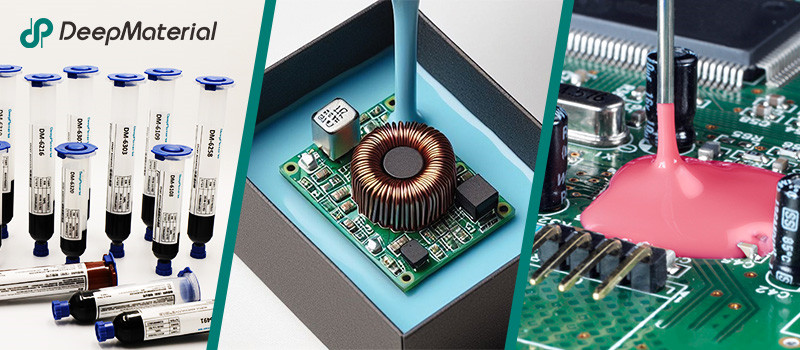
About DeepMaterial
DeepMaterial is a trusted supplier of encapsulant materials that are used in electronics manufacturing worldwide. From chip on board encapsulants such as glob top material to conformal coatings, underfills, low pressure molding, and potting solutions, DeepMaterial offers a full range of circuit board protection materials that effectively protect circuit boards while help reduce costs. More…Deepmaterial is a the manufacturer of epoxy adhesives including hardeners, metalbond, and metal filled resins. Structural, toughened medium viscosity, and non-sag adhesives are also offered. Some adhesives are resistant to thermal shock, chemical, vibration dampening, and impact. Suitable for metals, plastics, wood, and ceramics. Serves electronics, aerospace, automotive, tooling, marine, and construction industries. REACH and RoHS compliant. FDA approved. UL listed. Meets military specifications. We are the one of best adhesive manufacturers in China.
Blogs & News
Potting compounds are at the frontline of electronics assembly, delivering effective protection in challenging environmental conditions while improving mechanical strength and offering high electric insulation. Used within a variety of industries, electrical potting compounds are found within a broad range of consumer electronics, as well as used in applications across the automotive, aerospace, and other industries where electronic assemblies are prevalent.
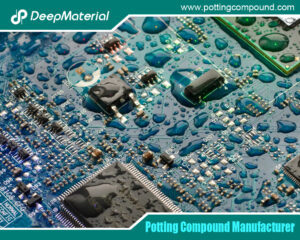
The Comprehensive Guide to Epoxy Potting Compound Manufacturers
The Comprehensive Guide to Epoxy Potting Compound Manufacturers Epoxy potting compounds are essential materials in the electronics industry, providing robust protection for sensitive components against
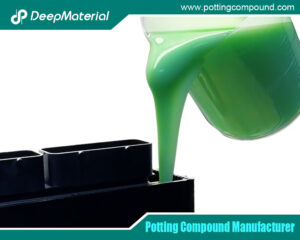
The Essential Guide to Potting Materials for Electronics
The Essential Guide to Potting Materials for Electronics In the rapidly evolving field of electronics, ensuring device reliability and longevity is critical. One of the
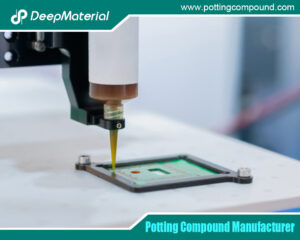
The Expanding Horizon of the Mini Silicone Optical Glue Market
The Expanding Horizon of the Mini Silicone Optical Glue Market The mini silicone optical glue market is witnessing unprecedented growth, fueled by technological advancements and
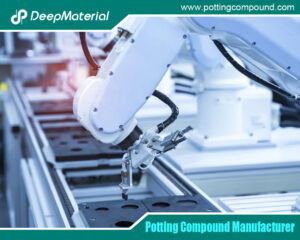
The Comprehensive Guide to PCB Potting Services: Ensuring Reliability in Electronics
The Comprehensive Guide to PCB Potting Services: Ensuring Reliability in Electronics Printed Circuit Boards (PCBs) are the backbone of modern electronics, enabling functionality in
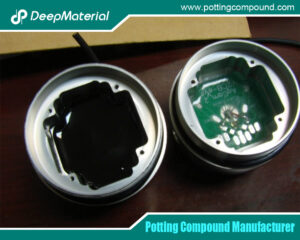
Comprehensive Insights on PCB Encapsulation in Potting Material
Comprehensive Insights on PCB Encapsulation in Potting Material In the fast-evolving landscape of electronics, ensuring the durability, reliability, and longevity of printed circuit boards
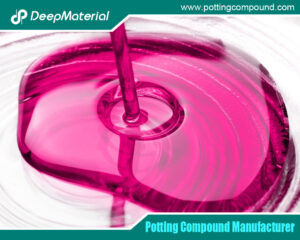
The Vital Role of Industrial Silicone Adhesive Manufacturers in Modern Industry
The Vital Role of Industrial Silicone Adhesive Manufacturers in Modern Industry In today’s fast-paced industrial landscape, the demand for reliable and durable adhesives is

